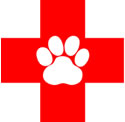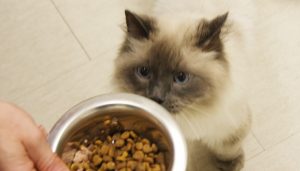 Changing a pet’s diet rapidly without a proper transition can lead to gastrointestinal upset such as diarrhea and/or vomiting. To avoid GI upset from sudden food changes, we recommend that you transition your pet gradually to a new diet. An example is provided below:
Changing a pet’s diet rapidly without a proper transition can lead to gastrointestinal upset such as diarrhea and/or vomiting. To avoid GI upset from sudden food changes, we recommend that you transition your pet gradually to a new diet. An example is provided below:
Day 1-2: 75 percent old diet and 25 percent new diet
Day 3-4: 50 percent old diet and 50 percent new diet
Day 5-6: 25 percent old diet and 75 percent new diet
Day 7+: 100 percent new diet
Mixing the new diet with the old diet will work for many pets. However, for some pets, especially cats, this may not be the best approach because they are by nature cautious about new odors, tastes and textures. A two-bowl method may be better to use in transitions. Offering a new diet in a separate bowl may be more effective for a change.
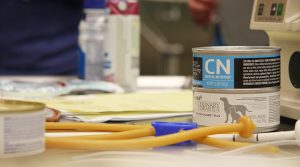 In general, we do not recommend feeding home-prepared diets. When possible, pets should be fed a commercially available diet produced by a reputable pet food company. These diets are generally more cost-effective, less labor-intensive and more consistent in ingredient sources than homemade diets.
In general, we do not recommend feeding home-prepared diets. When possible, pets should be fed a commercially available diet produced by a reputable pet food company. These diets are generally more cost-effective, less labor-intensive and more consistent in ingredient sources than homemade diets.
In addition, commercial diets are already complete and balanced for dogs and cats, whereas human foods are not. Some companies’ diets have even undergone feeding trials with extensive clinical research to support their efficacy.
Another problem with homemade diets is the phenomenon of ingredient drift. Although a homemade diet may meet nutrient requirements on paper, owners commonly modify them. Ingredients are added, subtracted or substituted without evaluation of their nutrient composition.
Without great care, table foods fed in sufficient amounts to meet caloric requirements are limited in their ability to meet all nutritional requirements for dogs. Over time, feeding table foods without an appropriate nutritional balance or the addition of vitamin and mineral supplements can lead to deficiencies of required nutrients.
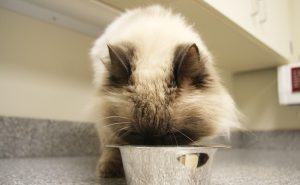 We do not routinely recommend the use of nutritional supplements. Supplements are rarely needed if a nutritionally complete and balanced, commercially produced diet is provided. Supplementation may nutritionally imbalance diets and on occasion interfere with management of diseases in dogs. Supplements can undermine the effectiveness of some cancer treatments.
We do not routinely recommend the use of nutritional supplements. Supplements are rarely needed if a nutritionally complete and balanced, commercially produced diet is provided. Supplementation may nutritionally imbalance diets and on occasion interfere with management of diseases in dogs. Supplements can undermine the effectiveness of some cancer treatments.
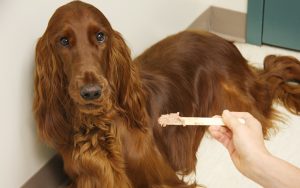 Because of the enormous variation in conformation among breeds (and even within a single breed), body weight alone is not a reliable indicator of health. In dogs and cats, we use a “body condition score” (BCS) system, a universally accepted and validated method of determining the ideal condition for any individual pet.
Because of the enormous variation in conformation among breeds (and even within a single breed), body weight alone is not a reliable indicator of health. In dogs and cats, we use a “body condition score” (BCS) system, a universally accepted and validated method of determining the ideal condition for any individual pet.
Several different scoring systems have been developed; the 9-point system is employed by many veterinarians. Both owners and veterinarians can use BCS charts to assess whether a pet’s food intake should be increased or decreased. For dogs, a BCS of 4 or 5 out of 9 is ideal. For cats, 5 out of 9 is ideal.
Purina offers helpful information about canine and feline obesity on its website.

